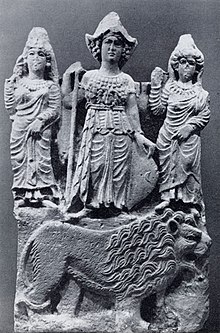Manat (goddess)
pre-Islamic Arabian goddess
Manāt (Arabic: مناة Arabic pronunciation: [maˈnaːh] pausa, [maˈnaːt] or Old Arabic manawat; also transliterated as manāh) was a pre-Islamic Arabian goddess worshipped in the Arabian Peninsula before the rise of Islam and the Islamic prophet Muhammad in the 6/7th century. She was among Mecca's three chief goddesses, alongside her sisters, Allat and Al-‘Uzzá,[1] and among them, she was the original and the oldest.

Quotes
edit- He sent Sa’d b. Zayd al-Ashhali to Manāt in al-Mushallal and he pulled it down.
- Al-Wāqidī’s Kitāb al-Maghāzī, edited by Rizwi Faizer, p.428
- The Quraysh as well as the rest of the Arabs continued to venerate Manah until the Apostle of God set out from Medina in the eighth year of the Hijrah[16], the year in which God accorded him the victory[17]. When he was at a distance of four or five nights from Medina, he dispatched ‘Ali to destroy her. ‘Ali demolished her, took away all her [treasures], and carried them back to the Prophet.
- Kitāb al-ʾAṣnām, translated by Nabih Amin Faris, p.14
External links
edit- Encyclopedic article on Manat (goddess) on Wikipedia